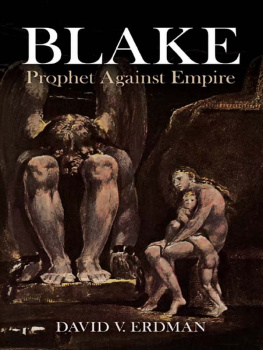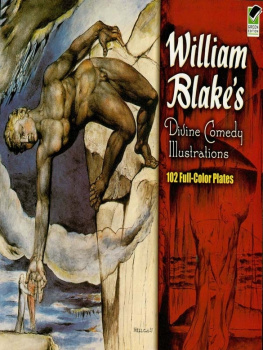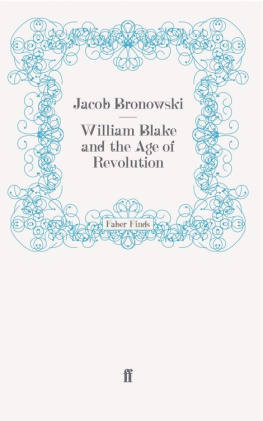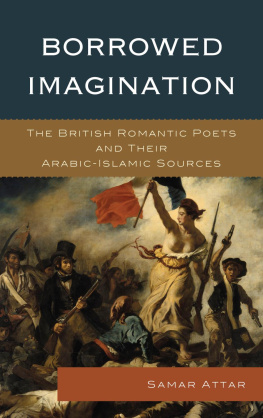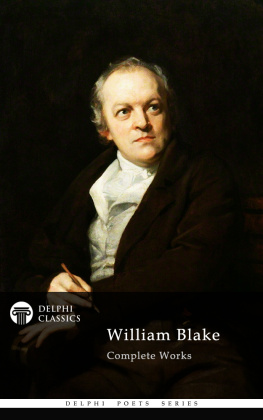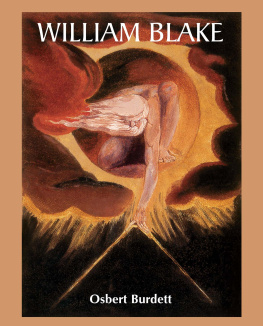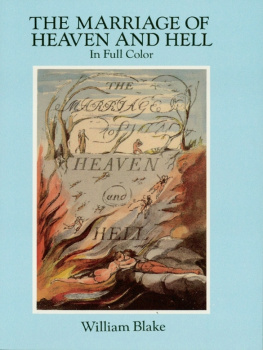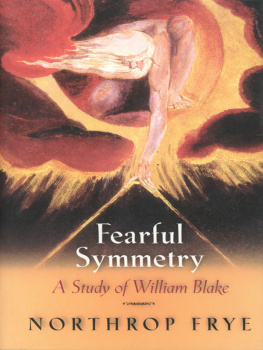BLAKE
PROPHET AGAINST
EMPIRE
BY
DAVID V. ERDMAN
Third Edition

D OVER P UBLICATIONS , I NC .
NEW YORK
Copyright 1954, 1969, 1977 by Princeton University Press.
All rights reserved.
This Dover edition, first published in 1991, is an unabridged republication of the third edition (1977) of the work originally published under the title Blake: Prophet Against Empire: A Poets Interpretation of the History of His Own Times by Princeton University Press, Princeton, New Jersey, in 1954.
Library of Congress Cataloging-in-Publication Data
Erdman, David V.
Blake: prophet against empire / by David V. Erdman.
p. cm.
Reprint. Originally published: 3rd ed. Princeton, N.J.: Princeton University Press, 1977.
Includes bibliographical references and index.
ISBN 0-486-26719-9 (pbk.)
1. Blake, William, 1757-1827Political and social views. 2. Political poetry, EnglishHistory and criticism. 3. Imperialism in literature. 4. Prophecies in literature. I. Title.
PR4148.P6E7 1991
821.7dc20
90-26552
CIP
Manufactured in the United States by Courier Corporation
26719904
www.doverpublications.com
Contents
T HE S EVEN years since publication of the Second Edition have seen a proliferation and intensification of Blake scholarship that have kept the study of his life and work and times an ever renewing delight. Historical documentation of the period has also grown increasingly sophisticated and extensive. No attempt has been made to incorporate all the new information and ideas, however. The new information alone in the thick volume of Blake Records (1969) by G. E. Bentley, Jr., some of which would involve contention about matters of dating and biographical interpretation, could change the shape of several chapters. My revisions have been limited to brief corrections of error or changes of perspective or brief notes of new material.
An Appendix has been added to contain notes of revision that overflow their pages. It includes as well several digests of recent studies that strikingly revise or enlarge the record of Blakes relations to contemporary and historical sources. The Index, which contained many erroneous page numbers in the Second Edition, has been thoroughly revised.
I am grateful to the many scholars whose work has enriched this edition, particularly to those who have supplied matter for the revisions and the Appendix. I must apologize to those whose suggestions and new material did not find room within the allotted space.
Crane Neck Point
June 1976
D.V.E.
S INCE 1954 the study of Blakes life, works, sources, and associationsand of the intellectual and social history of his timeshas altered and enlarged the intellectual context of this book. The temptation to revise entirely has at times been strong; in a paragraph or footnote here and there this edition is responsive to the urge to make a new assessment. But on the whole I have (with the encouragement of friends and critics) kept the main structure and in fact the text of this volume very much as they were. New biographical and bibliographical information relevant to Blakes interpretation of history has been incorporated as unobtrusively as possible. Quotations of Blakes writings have been corrected in the few places necessary and also brought closer to the original spelling and punctuation.
A few important and several minor readjustments have been necessitated by revised dating. We now know that the Blakes moved from 27 Broad Street in 1785, little more than a year after the partnership of Parker & Blake was formed; that they moved to Lambeth not in 1793 but in 1791thanks to the rate-book investigations of Paul Miner. Details in the style of Blakes lettering support other evidence that A Divine Image is an early, not a late, trial Song of Experience; that the Argument of The Marriage of Heaven and Hell is an original part of the work, not an addition. And the work of G. E. Bentley, Jr., and my own investigations have taught me that the stages and chronology of the manuscript of The Four Zoas are less definable than I had supposed.
To accommodate these and other revisions, some paragraphs have been moved forward or backward; some have been left standing, with notes of explanation. New material has generally been added in the notes, though occasionally by incorporation into the main narrative. Stanbury Thompsons discovery and publication of the Journal of John Stedman must be credited for the most fascinating new information, both about Blakes relations with author and publisher and printer and about his London, Stedman being a sort of Ginger Man. G. E. Bentleys notes have been useful for details here and there, particularly for the missing documentary link in the tale of Cromeks serpentine behavior. Many revisions and amplifications of historical particulars derive from the publications and conversation of E. P. Thompson and Lucyle Werkmeister. Martha England and Nancy Bogen have assisted in the revision of chapters dealing with An Island in the Moon; Mrs. Bogen and Mary S. Hall have communicated important discoveries about the sources and meanings of Tiriel. I have drawn afresh upon an ancient correspondence with Palmer Brown, and received much clarification from exchanges with S. Foster Damon and W. H. Stevenson. At the last minute Stanley Gardners Literature in Perspective Blake has added some vivid London details.
Too late for more than hasty perusal of its splendid and numerous illustrations came Kathleen Raines Blake and Tradition .
For continuing help and encouragement I am grateful to Sir Geoffrey Keynes, Northrop Frye, George Goyder, and F. W. Bateson; for criticism and particular advice, to Robert F. Gleckner and Edward J. Rose. For a variety of helpful suggestions and particular services I am indebted to Morton Paley and Ruthven Todd; also to Morchard Bishop, Harold Bloom, J. T. Boulton, Martin Butlin, Patrick J. Callahan, Kenneth Neill Cameron, Anne Freedgood, John E. Grant, William F. Halloran, Sally Hyde, Robert Kolker, Anne T. Kostelanetz, Lewis Patton, Vivian de Sola Pinto, Charles E. Robinson, Eric Robinson, Irene Tayler, and Michael Tolley. For indulgence as well as assistance I must also thank William L. Coakley, Marilan Lund, and Eugenia McGrath of the New York Public Library, and Cecelia Grimm and Lillian Silkworth of the State University of New York; and, beyond definition, the five persons of my dedication.
D.V.E.
Crane Neck Point
June 1969
W ITH the growth of interest in Blake as a poet of social vision the need has grown for a methodical study of his thought and art in relation to the history of his own times. Recent studies have related Blakes work to the Enlightenment and to the general context of the French Revolution and the Industrial Revolution. But General Knowledge is Remote Knowledge, as Blake was wont to insist, and we miss much of the vitality if not the sublimity of his Sublime Allegory addressed to the Intellectual powers as long as we remain only remotely acquainted with the acts of his age which he considered it his poetic duty to record and eternize.
Today it is not uncommon to find Blake regarded as the greatest of the Romantic poets or as the poet who means most for the modem world because of his awareness of the implications of history in the industrial epoch. Yet many of his shrewdest observations upon modem life are misconstrued, his pointed prophecies are treated as intentionally nonprophetic, his ironies and caricatures are taken for sober absurdities, and his unmistakably topical allusions are interpreted so carelessly that we have one decade mistaken for another, a counterrevolution for a revolution, a cabinet change for a riot, an orphan asylum for a madhouse, a recruiting officer for an agriculturist, andmost fundamentallyan indictment of war for an indictment of industry.
Next page
